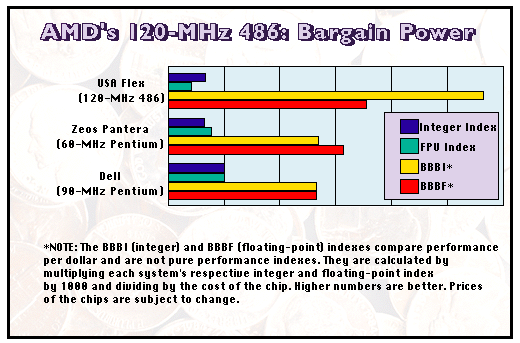| The 486 is reaching the end of its life, but it isn't
dead yet. Advanced Micro Devices (Sunnyvale, CA) has
developed two chips that shatter 486 speed barriers and
offer Pentium-level performance at low-end prices.
Meanwhile, Cyrix (Richardson, TX) has developed an unusual
CPU that's a cross between a 486 and a 586-class chip. Although AMD's new processors run internally at 120 and 133 MHz, they use clock-divided buses to remain compatible with existing motherboards. The 120-MHz 486 has a 40-MHz bus and delivers integer performance comparable to a 75-MHz Intel Pentium (see "AMD's 120-MHz 486: Bargain Power"). It began shipping this summer. AMD's 133-MHz 486 chip, which is due later this year, has a 33-MHz bus and a 16-KB unified write-back cache, which is twice as large and more efficient than the 8-KB write-through caches found on most 486 chips. However, due to its slower bus and the diminishing returns of pushing an older design to higher clock speeds, the 133-MHz 486 will offer only marginal performance improvement over the 120-MHz chip. Cyrix is trying to get around the problem of the 486's diminishing returns by introducing a hybrid design called the 5x86 (formerly known as the M1sc). The 5x86 will likely ship in volume by the end of this month. Depending on your point of view, the 5x86 is either a souped-up 486 or a stripped-down version of the M1, Cyrix's 586-class processor. Gone are the most advanced features that are supposed to make the M1 perform 30 percent to 50 percent faster than a Pentium: superscalar pipelines, speculative execution, extra registers, and a 64-bit data bus. Retained are several features typically found only in fifth-generation microarchitectures: branch prediction, data forwarding, an independent load/store unit, an 80-bit FPU, 64-bit internal data paths, and a 16-KB unified write-back cache. Internally, Cyrix's 5x86 runs at 100 MHz. Bus speeds can be 25, 33, or 50 MHz. Like a Pentium OverDrive, the 5x86 fits in a 32-bit 486 socket. Future versions will fit into 64-bit Pentium sockets and attain core speeds of as high as 200 MHz. Why bother with sub-586 designs when Intel is ramping up the Pentium and the sixth-generation P6? One reason: Both AMD and Cyrix are late in delivering their fifth-generation chips (neither the AMD K5 nor the Cyrix M1 will ship in quantity before 1996). Several vendors, including Cybermax, Liuski Systems, USA Flex, and Vobis, say they will use AMD's 120-MHz 486. However, at press time, major system vendors such as Compaq, which already uses AMD processors in some systems, had not committed to using AMD's new 486 chips. One vendor, which requested anonymity, said it would not use the 120-MHz 486 because it thinks Pentium prices will drop dramatically this fall. Prices to PC manufacturers for these crossover chips range from $120 for AMD's 120-MHz 486 to $147 for the Cyrix 5x86 (in quantities of 1000). That means complete systems can sell for under $1500, which is a key price point in retail channels. The pumped-up 486 chips should prosper in low-priced desktops and notebooks. For corporate and technical users, however, true 586-class chips look like a better buy. They're a safer long-term investment, and they offer superior performance, especially for floating-point tasks. AMD's 120-MHz 486: Bargain Power Copyright 1994-1998 BYTE |